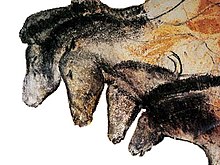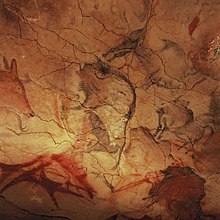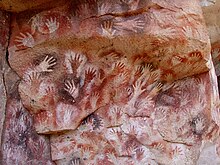List of Stone Age art

This is a descriptive list of Stone Age art, the period of prehistory characterised by the widespread use of stone tools. This article contains, by sheer volume of the artwork discovered, a very incomplete list of the works of the painters, sculptors, and other artists who created what is now called prehistoric art. For fuller lists see Art of the Upper Paleolithic, Art of the Middle Paleolithic, and Category:Prehistoric art and its many sub-categories.
Upper Paleolithic
Aurignacian
The oldest undisputed figurative art appears with the Aurignacian, about 40,000 years ago, which is associated with the earliest presence of Cro-Magnon artists in Europe. Figurines with date estimates of 40,000 years are the so-called Lion-man and Venus of Hohle Fels, both found in the Southern Germany caves of the Swabian Jura.
- zoomorphic figurine in the world and one of the oldest known examples of figurative art.[1] The figurine is now in the Museum Ulm, Ulm, Germany.
- Geißenklösterle cave, Swabian Jura, Germany. The posture of the figure is usually interpreted as an expression of worship, which is why in German the figure is called an "adorant", a word meaning a "worshipper". It is now in the Landesmuseum Württemberg, Stuttgart, Germany.
- mammoths, horse, etc.
- Venus of Hohle Fels, dated between 40,000 and 35,000 years ago, is a Venus figurine made of mammoth ivory. The figurine was found in Hohle Fels, Swabian Jura, Germany. The Venus of Hohle Fels is the oldest known undisputed depiction of a human. It is now in the Prehistoric Museum Blaubeuren, Blaubeuren, Germany.


- Cave art
- La Pasiega cave (Spain) – an art gallery created in prehistoric times, the exhibition of artwork here runs for at least 120 meters. Contains ladder-shaped abstract drawings controversially dated to older than 64,800 years (Mousterian).
- Altamira cave (Spain) – in 1879 the first prehistoric paintings and drawings were discovered in this cave, which soon became famous for their depth of color and depictions of animals, hands, and abstract shapes.
- Chauvet Cave (France) – some of the earliest cave paintings known, and considered among the most important prehistoric art sites.
- Coliboaia cave (Romania) contains the oldest known cave paintings of Central Europe, radiocarbon dated to 32,000 and 35,000 BP
- Lascaux caves (France) – contains some of the best known artworks of early painters, many of those portraying large animals.
- Bhimbetka rock shelters (India) – the shelters, decorated with art from 30,000 years ago, contain the oldest evidence of artists exhibiting their work on the Indian sub-continent.
Gravettian
The Gravettian spans the Last Glacial Maximum, ca. 33–21 kya. The Solutrean (c. 22–17 kya) may or may not be included as the final phase of the Gravettian.
- Numerous Venus figurines[6] from the Gravettian have been found including: Venus of Dolní Věstonice, Venus of Brassempouy, Venus of Laussel, Venus of Lespugue, Venus of Moravany, Venus of Galgenberg, Venus of Petřkovice, Venus of Savignano, Venus of Willendorf
- , showcase this gallery.
- Caves of Gargas, France, features numerous negative hand stencils, some with one or more fingers absent.
Epigravettian, Magdalenian
- Cave art
- Chufin cave (Spain) – small cave with engravings, stick figures, and artwork schematically portraying red deer, goats and cattle.
- Côa Valley(Portugal) – artists engraved thousands of drawings of horses and other animal, human and abstract figures in open-air artwork completed 22,000 to 10,000 years ago.
- Font-de-Gaume in south-west France contains over 200 polychrome paintings and engravings from artists who worked over 17,000 years ago. The cave's most famous painting is a frieze of five bison, although renditions of many other animals, including wolves, are featured.
- Kapova cave in southern Ural Mountains (Russia) – presently 173 monochromatic ochre rock paintings and charcoal drawings or their traces are documented, presenting Pleistocene animals and abstract geometric motives. They are about 18,000 – 16,000 years old, from Late Solutrean to Middle Magdalenian.
- La Marche (France) – due to the style the legitimacy of the cave paintings here are in dispute.
- Roc-aux-Sorciers (France) – a rock shelter famous for its 14,000-year-old relief wall carvings.
- Perforated baton with low relief horse, from Abri de la Madeleine, an overhanging cliff situated near Tursac in France, and is stored in the British Museum.
- 15 kya steppe wisent. The artist carved the bison's head turned to its right and licking itself as if bitten by an insect.[7] It's exhibited in the National Museum of Prehistory in Les Eyzies-de-Tayac-Sireuil, not far from where it was found.
- Montastruc decorated stone, an approximately 13,000 year old scratched or engraved human figure on a piece of limestone – which appears to be female –used as a lamp. Found in Courbet Cave, Penne, Tarn, France. It now resides in the British Museum of London.
- 13 kya Swimming Reindeer, a sculpture of two swimming reindeer ornately carved from the tusk of a mammoth. Found in Montastruc Rock Shelter, Bruniquel, Tarn-et-Garonne. The sculpture resides now in the British Museum.
- Robin Hood Cave Horse (previously known as the Ochre Horse). This fragment of rib that the artist engraved with a horse's head was discovered in the Robin Hood Cave in Creswell Crags, Derbyshire, England. It is the only animal-related Upper Paleolithic portable artwork ever found in Britain.[8][9] Robin Hood Cave Horse is now housed in the British Museum.
- Venus figurines of Gönnersdorf
- Venus figurines of Mal'ta, Venus of Buret'
- Pinhole Cave Man, or Pin Hole Cave Man, has become the common name for an engraving of a human figure on a woolly rhinoceros rib bone. The piece was found in Pin Hole Cave, Creswell Crags, Derbyshire, England, and is now in the British Museum.
Australasia

Australia and parts of Southeast Asia remained in the Paleolithic stage until European contact. The oldest firmly dated rock-art painting in Australia is a charcoal drawing on a rock fragment found during the excavation of the Nawarla Gabarnmang rock shelter in south western Arnhem Land in the Northern Territory. Dated at 28,000 years, it is one of the oldest known pieces of rock art on Earth with a confirmed date.
- These artworks are well over 20,000 years old.
- 95% CI), consistent with the reports that the cave was still visited within living memory.[13]
- Aboriginal rock art, which date from 5,000 to 7,000 years old.[14]
Mesolithic

- Mesolithic Europe
- 12.5 kya spear thrower carved by the artist into the form of a Mammoth was discovered at the rock shelter of Montastruc, Tarn-et-Garonne, France. It is now exhibited in the British Museum.
- 12 kya Cuciulat cave (Romania) features several red paintings of animals, including horses and felines, which are about 12,000 years old. These were the first manifestations of this kind known in Central Europe.
- 11.5 kya The Shigir Idol, a wooden sculpture, resides in the Historic Exhibition Museum in Yekaterinburg, Russia.
- 11 kya Venus of Monruz (Switzerland)
- 11 kya
- 10-8 kya Magura Cave (Bulgaria) - the prehistoric wall paintings of Magura have great resemblance with those of the Grotta dei Cervi in Italy, which are of exceptional expression and artistic depth and are considered the most significant works of art of the European Post-Paleolithic era.[16] In 1984 the site was induced into UNESCO's tentative list of World Heritage.[17]
- 10-5.5 kya Rock art of the Iberian Mediterranean Basin
- 9 kya Elk's Head of Huittinen, sculpture exhibited at the National Museum of Finland.
- 7 kya Republic of North Macedonia. The artist depicts a sitting male body, and shows details of his spine, ribs, navel, and phallus. The piece is now exhibited in the Skopje City Museum.
- 11 kya Ain Sakhri caves near Bethlehem, is the oldest known representation of humans engaged in sex.[18] It is now displayed in the British Museum.
- Mesolithic Asia
- 16 kya Zuojiang Huashan Rock Art features rock paintings on limestone cliff faces in Guangxi, southern China.
- 10 kya Bhimbetka rock shelters (World Heritage Site), Madhya Pradesh, India with rock art ranging from the Mesolithic (c.8,000 BC) to historical times[19][20][21][22][23][24]
- North African Mesolithic
- Sahara desert.
- Tadrart Acacus(Libya) – rock art with engravings of humans and flora and fauna, which date from 12,000 BCE to 100 CE.
- Tassili n'Ajjer (Algeria) – over 15,000 pastoral and natural engravings; the earliest rock art is from around 12,000 years before present, with most dating to the 9th and 10th millennia BP or younger.
- Americas

- Cueva de las Manos (Cave of Hands) (Argentina) – a series of caves exhibiting hundreds of outlines of human hands, hunting scenes, and animals painted 13,000 to 9,000 years ago.[25]
- Bird stones (5,000 to 2,500 years old) are portable bird-shaped stone sculptures created by generations of North American sculptors.
- Toquepala Caves (Peru) – "Abrigo del Diablo" and the other caves contain at least 50 noted pieces. The artists used paint made from hematite, and painted in seven colors with red being dominant.[26][27][28]
Neolithic
- Near East and North Africa
- murals, figurines, and depictions of animals. The Seated Woman of Çatalhöyükwas found here.
- Seated Woman of Çatalhöyük is a baked-clay nude female form seated between feline-headed arm-rests which is missing its original head and right side hand rest (although reconstructions of the artist's possible intent have been added). Resides at the Museum of Anatolian Civilizations in Ankara, Turkey.
- Rock art of Figuig(Morocco)
- Rock art of south Oran (Algeria)
- Rock art of the Djelfa region (Algeria)

- The Alunda moose is a Neolithic artistic stone axe c.2000 B.C. that was found in Uppland, Sweden. It is displayed in the Swedish History Museum.
- Dagenham idol
- Westray Wife
- Folkton Drums
- Rock carvings at Alta (Norway) – artwork includes images of Bear worship.
- Rock art of the Iberian Mediterranean Basin
- List of stone circles
- Stone circles in the British Isles and Brittany
- Neolithic China
- Wenshan Prefecture, Yunnan, China.
See also
- Art of the Middle Paleolithic
- Art of the Upper Paleolithic
- British Museums' Department of Prehistory and Europe
- Cave paintings
- Caves in Cantabria
- Cave of Forgotten Dreams, a 2010 documentary film about Chauvet Cave by Werner Herzog.
- Earliest findings for hominid art
- History of painting
- History of sculpture
- Indigenous Australian art
- Inside the Neolithic Mind, 2005 book
- International Federation of Rock Art Organizations
- Ochre Processing Workshop
- Parietal art
- Petroglyph#List of petroglyph sites
- Pre-Columbian art in the Americas
- Prehistoric art
- Rock Art and the Prehistory of Atlantic Europe, 1997 book
- The Mind in the Cave: Consciousness and the Origins of Art, 2002 book
- The Thread of Art, 2012 and 2015 book
- Rock art
References
- ^ Kind, C.-J.; Ebinger-Rist, N.; Wolf, S.; Beutelspacher, T.; Wehrberger, K. (2014). "The Smile of the Lion Man. Recent Excavations in Stadel Cave (Baden-Württemberg, south-western Germany) and the Restoration of the Famous Upper Palaeolithic Figurine" (PDF). Quartär. 61: 129–145. Archived from the original (PDF) on 2017-08-22. Retrieved 2021-04-25.
- S2CID 7807664.
- ^ "Oldest confirmed cave art is a single red dot" by Michael Marshall, New Scientist, 23 June 2012, pp. 10-11.
- ISBN 0-87480-758-1. Translation of La Grotte Chauvet, l'art des origins, Éditions du Seuil, 2001, p. 214.
- ^ Amos, Jonathan (June 14, 2012). "Red dot becomes 'oldest cave art'". BBC News. Archived from the original on 13 January 2013. Retrieved 15 June 2012.
One motif – a faint red dot – is said to be more than 40,000 years old.
- ISBN 9780199675616.
- ^ "Collections", National Museum of Prehistory Archived 2015-04-30 at the Wayback Machine in Les Eyzies-de-Tayac-Sireuil (in French)
- ^ "Horse engraving on bone". British Museum. 2011. Archived from the original on 22 October 2012.
- ISBN 978-0-7141-1376-0. Retrieved 14 October 2011.
- ^ Donaldson, Mike The Gwion or Bradshaw art style of Australia's Kimberley region is undoubtedly among the earliest rock art in the country –but is it Pleistocene? Archived 2016-03-05 at the Wayback Machine (free download) L'art pléistocène en Australie (Pré-Actes) IFRAO Congress, September 2010 p. 4.
- ^ Masters, Emma (4 October 2009). "Aboriginal rock art collection 'world's largest'". ABC News (Australian Broadcasting Corporation).
- S2CID 134077798.
- ^ Robert Gunn, Bruno David, Jean-Jacques Delannoy and Margaret Katherine, "The past 500 years of rock art at Nawarla Gabarnmang, central-western Arnhem Land" in: Bruno David, Paul S.C. Taçon, Jean-Jacques Delannoy, Jean-Michel Geneste (eds.), The Archaeology of Rock Art in Western Arnhem Land, Australia (2017), pp. 303–328.
- ^ "Aboriginal heritage". Office of Environment and Heritage. Government of New South Wales. Retrieved 7 May 2011.
- ^ "Les Combarelles – Grotte – Eyzies-de-Tayac – Périgord – Dordogne" (in French). Hominidés.com. December 2007. Retrieved 1 May 2011.
- ^ "Bulgarian rock art: the Magura Cave paintings". TRACCE Online Rock Art Bulletin. November 19, 2014. Retrieved 21 Nov 2014.
- ^ "The Magoura Cave with drawings from the bronze age". UNESCO World Heritage Centre. Retrieved 16 May 2013.
- ^ A History of the World -7, BBC.co.uk, accessed July 2010
- ^ "Rock Shelters of Bhimbetka". World Heritage Site. Retrieved 2007-02-15.
- ISBN 9788170171935.
- ISBN 9788176250863.
- ^ Rock Shelters of Bhimbetka (PDF). UNESCO. 2003. p. 16.
- ISBN 9781780222592.
- ISBN 9780875864846.
- ^ Cueva de las Manos at the UNESCO:
- UNESCO World Heritage Centre. "Cueva de las Manos, Río Pinturas". UNESCO World Heritage Centre. Archived from the original on 2021-04-14. Retrieved 2021-04-07.
- World Heritage Sites: a Complete Guide to 1007 UNESCO World Heritage Sites (6th ed.). OCLC 910986576.
- ^ South American Handbook. Trade and Travel Publications Limited. 1976.
- ISBN 978-0-7425-0256-7.
- ISBN 978-1-58729-474-7.

